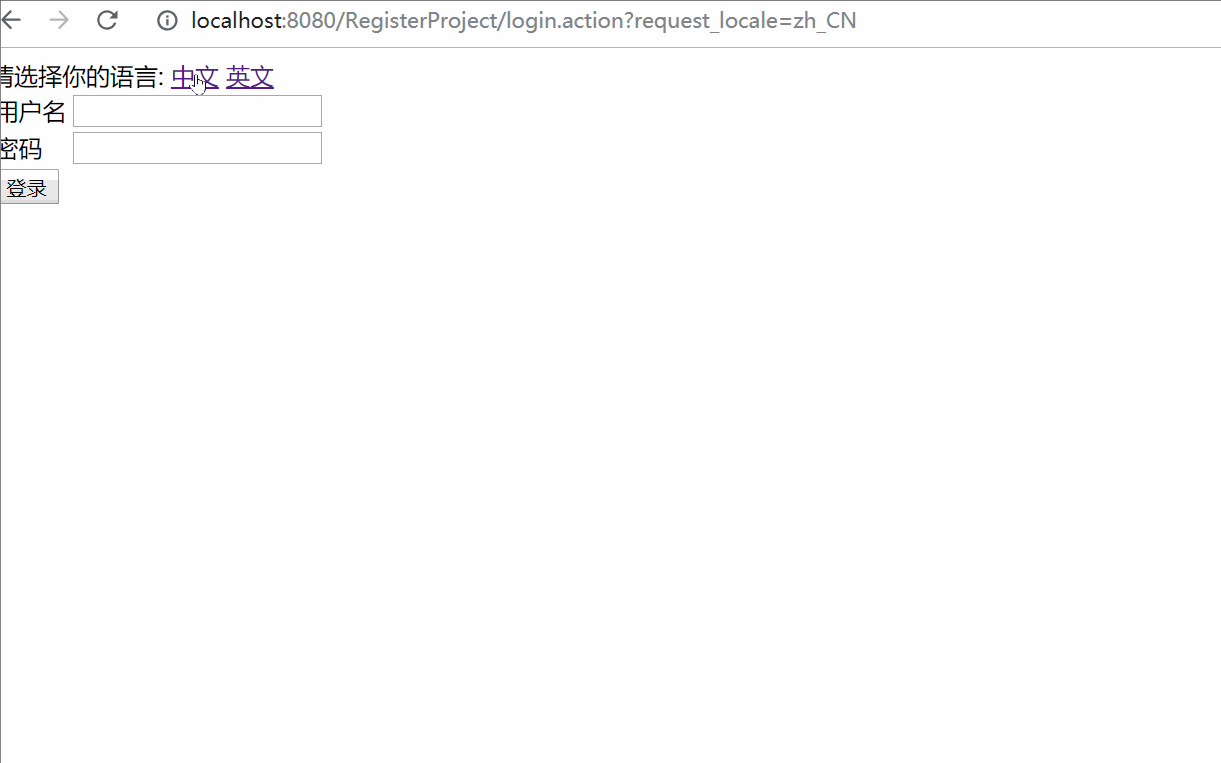Struts2國際化-中英文轉換
阿新 • • 發佈:2018-12-19
先在src下建立兩個File,提供程式所需的資原始檔
(粗心的程式設計師可要注意了File檔名一定不要寫錯,該檔案以key,value的形式出現)具體程式碼如下:
接下來寫檢視層index.jsp內程式碼
<%@ page language="java" import="java.util.*" pageEncoding="UTF-8"%> <% String path = request.getContextPath(); String basePath = request.getScheme()+"://"+request.getServerName()+":"+request.getServerPort()+path+"/"; %> <%@ taglib prefix="s" uri="/struts-tags"%> <!DOCTYPE HTML PUBLIC "-//W3C//DTD HTML 4.01 Transitional//EN"> <html> <head> <base href="<%=basePath%>"> <title>中英文切換</title> </head> <body> <s:i18n name="message"> <s:text name="check"></s:text>: <a href="login.action?request_locale=zh_CN"><s:text name="chinese"></s:text></a> <a href="login.action?request_locale=en_US"><s:text name="english"></s:text></a> <form action="<%=basePath%>t1" method="post"> <table> <tr> <td><s:text name="login.username"/></td> <td><input type="text" name="user.userName"/></td> </tr> <tr> <td><s:text name="login.password"/></td> <td><input type="text" name="user.password"/></td> </tr> <tr> <td colspan="2"><input type="submit" value="<s:text name="login.btn"/>"/></td> </tr> </table> </form> </s:i18n> </body> </html>
其中a標籤的login為struts.xml 的action name屬性。
其次是controller層封裝類indexAction但“execute”和“success”為可變因素但切記一定要在struts.xml中配置所對應的屬性名,否則就找不到所對應的action。
package com.hnpi.action; import com.opensymphony.xwork2.ActionSupport; public class indexAction extends ActionSupport{ private String name; private String pwd; public String getName() { return name; } public void setName(String name) { this.name = name; } public String getPwd() { return pwd; } public void setPwd(String pwd) { this.pwd = pwd; } public String execute(){ return "success"; } }
在建立一個action,裡面只放一個execute方法
package com.hnpi.action;
public class LanguageAction {
public String execute(){
return "success";
}
}
然後配置最為重要的struts.xml頁面。
<?xml version="1.0" encoding="UTF-8"?> <!DOCTYPE struts PUBLIC "-//Apache Software Foundation//DTD Struts Configuration 2.0//EN" "http://struts.apache.org/dtds/struts-2.0.dtd"> <struts> <package name="default" namespace="/" extends="struts-default"> <action name="t1" class="com.hnpi.action.indexAction"> <result name="success">/welcome.jsp</result> </action> <action name="login" class="com.hnpi.action.LanguageAction"> <result name="success">/index.jsp</result> </action> </package> </struts>
這裡一定要小心class的路徑和action name的屬性名稱(result name屬性的名稱為封裝類中execute類的返回內容)
最後配置web.xml檔案,該配置檔案內容為固定搭配,一定要熟記。
<?xml version="1.0" encoding="UTF-8"?>
<web-app version="2.5"
xmlns="http://java.sun.com/xml/ns/javaee"
xmlns:xsi="http://www.w3.org/2001/XMLSchema-instance"
xsi:schemaLocation="http://java.sun.com/xml/ns/javaee
http://java.sun.com/xml/ns/javaee/web-app_2_5.xsd">
<welcome-file-list>
<welcome-file>index.jsp</welcome-file>
</welcome-file-list>
<filter>
<filter-name>struts2</filter-name>
<filter-class>org.apache.struts2.dispatcher.ng.filter.StrutsPrepareAndExecuteFilter</filter-class>
</filter>
<filter-mapping>
<filter-name>struts2</filter-name>
<url-pattern>/*</url-pattern>
</filter-mapping>
</web-app>
最後是我的程式執行效果圖




